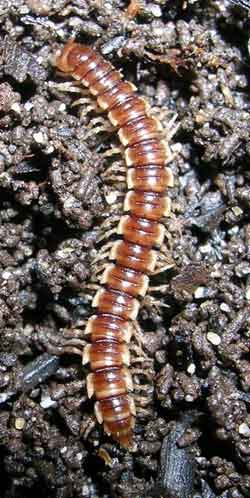The secret life of millipedes

This is a specimen of Oxidus gracilis.<br>Credit: Giuseppe Fusco<br>
Millipede puberty is a radical affair. The change in function from leg to gonopod can occur within a couple of moults, during which the millipede typically adds more segments to its length and sheds its too-small skin.
These animals are difficult to study with standard techniques due to their hard exoskeleton, because secretions from their stink-glands interfere with most conventional microscopy preparation techniques. However, using confocal laser scanning microscopy, researchers from the University of Padova were able to investigate this dramatic transformation throughout the relevant moults.
Conversion of legs to gonopods first requires regression of the legs in segment VII into tiny primordia. The primordia then develop into gonopods and the exoskeleton rearranges, producing a gonopodal sac which shelters the base of the gonopods and a U-shaped apodeme, to act as an anchor point for the bulky muscles required to operate the gonopods. In three species out of the four investigated, some of these muscles, both protractors and retractors , extend to attach to skeletal structures on the flanking segments, VI or VIII, and another muscle (abductor) stretches across the pair of appendages to move them apart in a pincer movement.
Dr Leandro Drago, one of the team who performed this work, said that, “Conversion of legs into specialized gonopods via non-systemic metamorphosis is not a simple matter of changing the appearance of the legs and adding spines. The exoskeleton and muscle reorganization of segment VII during sexual development forces the nerve cord to become displaced and a causes a reduction in the volume of digestive tract through this segment.”
Dr Drago continued, “This may well impact the amount of food an adult male millipede can eat and may be why they appear to lose weight when sexually mature. Males of some species of millipede can revert back into an immature stage (periodomorphosis) which may be an adaption to prevent starvation.”
Notes to Editors
1. Structural aspects of leg-to-gonopod metamorphosis in male helminthomorph millipedes (Diplopoda)
Leandro Drago, Giuseppe Fusco, Elena Garollo and Alessandro Minelli
Frontiers in Zoology (in press)
Please name the journal in any story you write. If you are writing for the web, please link to the article. All articles are available free of charge, according to BioMed Central's open access policy.
Article citation and URL available on request at press@biomedcentral.com on the day of publication.
2. Frontiers in Zoology is an Open Access, peer-reviewed online journal publishing high quality research articles and reviews on all aspects of animal life.
3. BioMed Central (http://www.biomedcentral.com/) is an STM (Science, Technology and Medicine) publisher which has pioneered the open access publishing model. All peer-reviewed research articles published by BioMed Central are made immediately and freely accessible online, and are licensed to allow redistribution and reuse. BioMed Central is part of Springer Science+Business Media, a leading global publisher in the STM sector.
Media Contact
More Information:
http://www.biomedcentral.comAll latest news from the category: Life Sciences and Chemistry
Articles and reports from the Life Sciences and chemistry area deal with applied and basic research into modern biology, chemistry and human medicine.
Valuable information can be found on a range of life sciences fields including bacteriology, biochemistry, bionics, bioinformatics, biophysics, biotechnology, genetics, geobotany, human biology, marine biology, microbiology, molecular biology, cellular biology, zoology, bioinorganic chemistry, microchemistry and environmental chemistry.
Newest articles

Superradiant atoms could push the boundaries of how precisely time can be measured
Superradiant atoms can help us measure time more precisely than ever. In a new study, researchers from the University of Copenhagen present a new method for measuring the time interval,…

Ion thermoelectric conversion devices for near room temperature
The electrode sheet of the thermoelectric device consists of ionic hydrogel, which is sandwiched between the electrodes to form, and the Prussian blue on the electrode undergoes a redox reaction…

Zap Energy achieves 37-million-degree temperatures in a compact device
New publication reports record electron temperatures for a small-scale, sheared-flow-stabilized Z-pinch fusion device. In the nine decades since humans first produced fusion reactions, only a few fusion technologies have demonstrated…





















